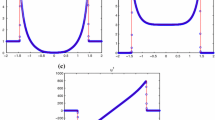Abstract
For the full or isenthalpic Euler equations combined with the ideal-gas law, the flux-vector splitting presented here is, by a great margin, the simplest means to implement upwind differencing. For a polytropic gas law, with γ > 1, closed formulas have not yet been derived.
The scheme produces steady shock profiles with two interior zones. There is evidence [10] that, among implicit versions of upwind methods, those with a two-zone steady-shock representation give faster convergence to a steady solution than those with a one-zone representation.
A disadvantage in using any flux-vector splitting is that it leads to numerical diffusion of a contact discontinuity at rest. This diffusion can be removed; present research is aimed at achieving this with minimal computational effort.
Numerical solutions by first- and second-order schemes including the above split fluxes can be found in Refs. [6], [7] (one-dimensional) and [8], r91 (two-dimensional).
Research was supported under NASA Contract No. NAS1-15810 while the author was in residence at ICASE, NASA Langley Research Center, Hampton, VA 23665.
Preview
Unable to display preview. Download preview PDF.
Similar content being viewed by others
References
P.L. Roe, J. Computational Phys. 43 (1981), 357.
S. Osher, “Numerical solution of singular perturbation problems and hyperbolic systems of conservation laws”, North-Holland Mathematical Studies 47 (1981), 179.T
R.H. Sanders and K.H. Prendergast, Astrophys. J. 188 (1974), 489.
J.L. Steger and R.F. Warming, J. Computational Phys. 40 (1981), 263.
A. Harten, P.D. Lax and B. van Leer, “Upstream differencing and Godunov-type schemes”, ICASE Report No. 82-5; to appear in SIAM Review.
J.L. Steger, “A preliminary study of relaxation methods for the inviscid conservative gasdynamics equations using flux-vector splitting”, Report No. 80-4, August 1980, Flow Simulations, Inc.
G.D. van Albada, B. van Leer and W.W. Roberts, Jr., “A comparative study of computational methods in cosmic gas dynamics”, Astron. Astrophys. 108 (1982), 76.
G.D. van Albada and W.W. Roberts, Jr., Ap. J. 246 (1981), 740.
M.D. Salas, “Recent developments in transonic flow over a circular cylinder”, NASA Technical Memorandum 83282 (April 1982).
P.M. Goorjian and R. van Buskirk, “Implicit calculations of transonic flow using monotone methods”, AIAA Paper 81-331 (198,1).
Author information
Authors and Affiliations
Editor information
Rights and permissions
Copyright information
© 1982 Springer-Verlag
About this paper
Cite this paper
van Leer, B. (1982). Flux-vector splitting for the Euler equations. In: Krause, E. (eds) Eighth International Conference on Numerical Methods in Fluid Dynamics. Lecture Notes in Physics, vol 170. Springer, Berlin, Heidelberg. https://doi.org/10.1007/3-540-11948-5_66
Download citation
DOI: https://doi.org/10.1007/3-540-11948-5_66
Published:
Publisher Name: Springer, Berlin, Heidelberg
Print ISBN: 978-3-540-11948-7
Online ISBN: 978-3-540-39532-4
eBook Packages: Springer Book Archive




